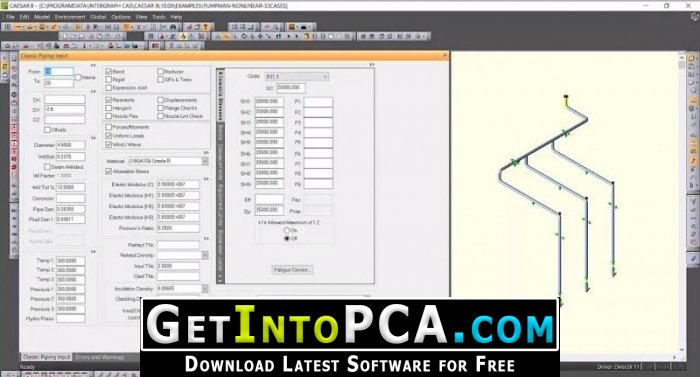2020. 3. 2. 18:12ㆍ카테고리 없음

Finally I got the scope to use the latest version of Caesar II 2018 version 10.00 which was released by Intergraph Inc in August last year. Like every new version they have added many additional features alongwith updation based on latest code requirements. In this article I will be sharing few of the improvements that I got to notice at first instance. Request other readers to add additional capabilities that you find while using Caesar II latest version in comments section. They have Expanded the Restraints auxiliary panel (Refer Fig.

1) with two additional restraint definitions to support six degrees of freedom. So now one can add all six degrees of freedom in the same restraint node.
1: Caesar II Version 2018 vs 2017. As shown in Fig. 1, they have added a new Tag field for each restraint definition in the latest version. Added the Element Name field (Fig. 1) to the Piping Input window and to the Elements list input. Element names also display in force reports, stress output reports, and stress isometric drawings. Added new Tag and GUID columns to the Restraints list input.
These fields reflect the new capability of the software to read and import support ID and display-only support GUID data from PCF files. 2.
Also Updated the Hangers list input to include the hanger Tag and the display-only hanger GUID columns (Fig 2). These fields reflect the new capability of the software to read and import hanger ID and display-only hanger GUID data from PCF files. Added Tag field to the Hangers auxiliary panel and to in the Piping Input. 2: New TAG and GUID features of Caesar II 2018.
Added the Show Tags (Fig. 3) option to Options Node Numbers to allow the display of support tags, hanger tags, and element names in the graphic view. One can map the attribute definitions from the NAME or TAG attributes to the Tag field. You can also display tag and GUID data in annotations in stress isometric drawings. Added Tag/GUID fields (for supports/restraints, hangers, and element names) in applicable output reports and in the MDB output tables. Set North Direction (Fig.
3) replaces Model Rotation in the Advanced PCF Import (APCF) and Special Execution Parameters dialog boxes. Model Orientation replaces Model Rotation in the Load S3D/SPR Model dialog box. You can specify the orientation of the Smart 3D or SmartPlant Review model to be imported. This is useful when you do not use the default CAESAR II mapping.
3: Showing North Direction and Support TAG. When you delete pipe elements, the software retains the original nodal coordinates for all disconnected segments, instead of resetting the starting coordinates of those segments to the global setting (0,0,0) which used to happen for all earlier version. Implemented find and replace functionality (Fig. 4) within the List dialog.
You can use the Find/Replace option on the right-click menu in the List dialog to search and replace data in a selected column. Added Previous and Invert options to the Line Numbers dialog box in Classic Piping Input and Static Output Processor. Previous allows you to save the current view and return to the previous view.
Invert allows you to toggle line number selections.
Caesar Ii Software Subscription
The Intergraph Process, Power & Marine team has released CAESAR II 2018.